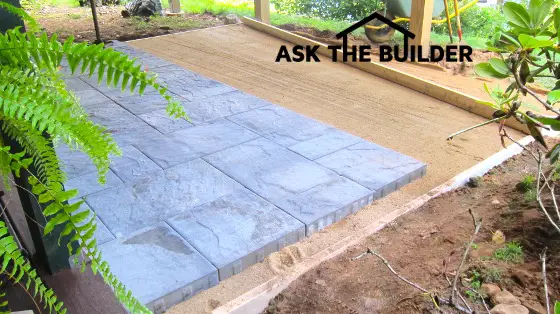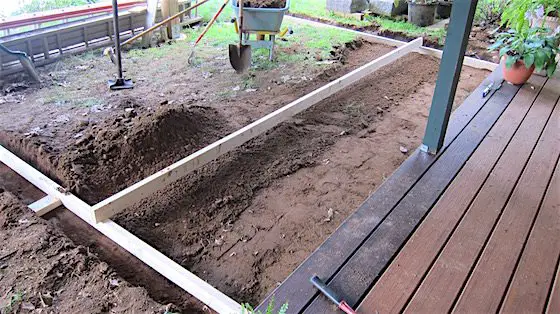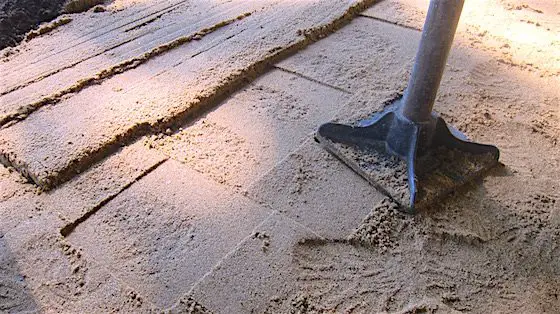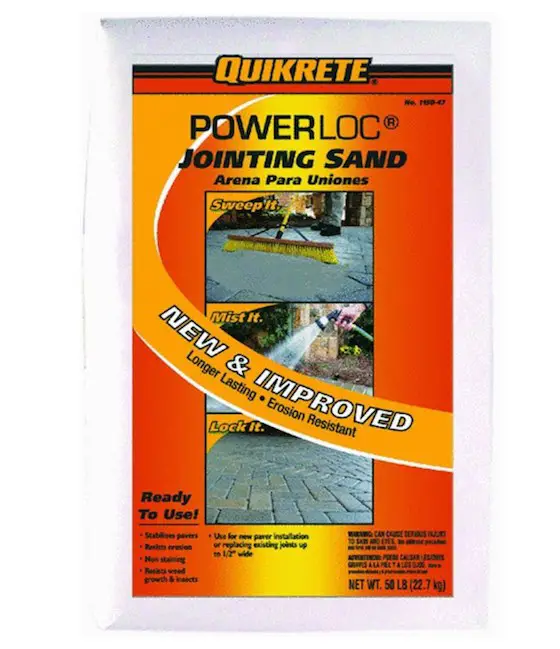Patio Paver DIY

Patio Paver DIY | This patio paver job is being done by a 65-year-old man. If he can do it with no helpers, so can you! The large-format pavers can be heavy so only buy what you can hold and place with relative ease. This was featured as "Quick Story" in the July 30, 2017 AsktheBuilder Newsletter. (C) Copyright 2017 Tim Carter
"Ask five different paver contractors the way to install the paving stones and you might get five different methods. What really matters is the strength of the underlying soil under your patio, the size of the pavers you intend to use and how much weight will be placed upon any given paver."
Paver Patio DIY TIPS
- Visit different suppliers to see all the varied pavers
- Lift the stones to see if you can handle them
- WATCH the videos below to help you understand sand strength
- Use concrete sand for simple backyard patios and walkways
- CLICK HERE to Get Tim's FREE & FUNNY Newsletter!
DEAR TIM: I’ve decided it’s time for a patio in my rear yard. After visiting a local business that sells a vast variety of different patio pavers, I’m ready to start.
Do you think this is a real DIY job or am I being too ambitious? After watching a number of videos on YouTube, I’m more confused than ever about the best base material.
Have you installed these patio stones and what method do you recommend? Are there any hidden surprises with precast concrete patio pavers? Sue T., Racine, WI
DEAR SUE: You must have been in contact with my wife. She loves patios and has been wanting one here at our New Hampshire home for a few years. I had constructed a huge brick patio for her many years ago at our last home and she misses it.

I'm using 2x4s to guide me so I don't dig out too much dirt.The parallel 2x4s have been set using a builder's level and slope away from the house. The 2x4 on top allows me to ensure I only dig out 3.5 inches of dirt. Next to the deck you can see how the loose dirt was compacted using the heavy steel hand tamper. Copyright 2018 Tim Carter
Where Do You Purchase Patio Pavers?
We did the same thing you did just a week ago. We went to a large local business that stocks just about any type of natural stone or precast concrete paver that’s available. It was exciting for me to see how the patio paver industry has matured.
I can clearly remember how limited the selection was many years ago when the first generation of this building material hit the marketplace. Decades ago all you could get were simple brick that measured about 4 x 8 inches. Now there are dozens of shapes, colors and textures.
Free & Fast Bids
What Type of Textures Are Available?
Kathy decided to go with a stunning paver that has a textured top surface that resembles slate. This design creates a random texture with deep shadow lines that might fool some into thinking it’s real slate.
Be sure you visit several stone and paver suppliers to see all the different patterns, colors and textures that are available. Not every business stocks every precast concrete paver.
Conflicting Installation Information Out There - BEWARE!
I happened to watch some of the videos online and shook my head. Installation methods meant for city streets were being touted as the way to do a small residential backyard patio that may have a lawnmower ride over it instead of a 40-ton loaded concrete truck!
Here's an example of a somewhat confusing video. This is a great video, but the deep gravel base they used will work to support large trucks on a driveway. The work being done was for a backyard patio that will just support the weight of people walking on it.
If you're a contractor reading this column, before you get your knickers in a knot, think about driving your car or pickup truck on nothing more than sand.
Yeah, I'll bet you never gave that a thought. Watch the following video and think about the concentrated loads at each tire. Some of the pickup trucks you see in this video weigh about 6,000 pounds.
The contact area where each tire touches the sand is only a small square about 6 inches on a side! Compacted sand that can't move sideways is very strong!
That means compacted sand alone would work fine for a simple backyard paver patio. Read more of Tim's comments on compacted sand in the May 13, 2018 AsktheBuilder Newsletter.
Do You Have To Put Gravel Under The Patio Pavers?
Ask five different paver contractors the way to install the paving stones and you might get five different methods. What really matters is the strength of the underlying soil under your patio, the size of the pavers you intend to use and how much weight will be placed upon any given paver.
Realize that compacted sand can be incredibly strong and is an easy material for a DIY person to handle.
Do Driveways Require the Gravel Base?
Precast concrete pavers that have to support the weight of cars, trucks and the like need a deep compacted base of crushed gravel. Compacted concrete sand is often placed on top of this. A thin final layer of setting sand is the actual surface you place the pavers onto.
Are Large Pavers An Advantage?
Larger paving stones act like building footings. They spread the weight put upon them across a greater area. This is why Kathy and I decided to use a three-piece set of pavers where the largest one measures 16 by 24 inches! Because our patio measures 10 by 24 feet, the large format also looks more to scale.
Can Just Sand Support A Car or Truck?
Here’s something that many installers seem to forget. You can drive your car or truck on many sand beaches here in the USA.
I’ve done it with my full-sized pickup truck!
Sand Is Just Small Rock
Realize the vast majority of sand you see is just small pieces of rock. On some beaches it can be tiny pieces of sea shells or broken coral. In other words, compacted sand can provide a sufficient base for a paver patio that’s just going to have you walking across it.
Is a Paver Patio Really a DIY Job?
I fully believe if you’re in decent physical condition you can do this entire job yourself. Your only limitation is going to be if you can lift and hold the paving stones with your two hands. You need to be able to place the pavers very carefully so they drop onto the final layer of sand as flat as possible. When you visit the businesses that sell the stone, try to lift the largest paver you’re thinking of using.
Many Patios = Tested Methods
I’ve installed many paver patios. As you might suspect, I decided to test different methods for patios trying to discover the best method requiring the least amount of work. Using my geology degree and some common sense, I finally settled on using concrete sand under my patio pavers. The method I’d use for a paver driveway differs from what I’m about to share.
How Much Sand Is Needed?
Just a few days ago, I excavated the soil and then used a hand tamper to compact any disturbed soil. I then set wood forms on the soil that extended a minimum of 3 inches beyond the edge of the finished pavers. Just as roads have shoulders to support the pavement, I wanted my compacted sand to extend beyond the patio edge.

The upper left of the photo shows 3.5 inches of uncompacted sand that was dumped in between the two parallel 2x4s. I used the other 2x4 to scrape off any excess. Then I used the hand tamper to compact it. You can clearly see I was able to get it to compact 1 inch. I then gently sprinkled it with lots of water to help further compact it. Copyright 2018 Tim Carter
Concrete Sand Is Best
I like concrete sand because it has a wide variety of rock particles in the sand that range from fine sand all the way up to stones that are about the size of green peas. This sand is easy to shovel and place. I put down 3.5 inches and used my hand tamper to compact it. The tamper compacted this at least 3/4 of an inch. In some areas the sand compacted 1 inch.
Is It A Good Idea To Water The Sand?
I then used my garden hose with the garden nozzle set to shower to thoroughly wet down the compacted sand. The water flowing through the sand further consolidates the sand just as the sea water does at the beach.
The next step is to place the final thin layer of concrete sand on top of the compacted sand. You set your pavers on this layer gently making sure the edges of the pavers touch one another and they are set flat on the sand.
What Is Polymeric Sand For Joints?
The final step is to use new polymeric colored sand to fill the joint between the pavers.

Here's but one type of polymeric sand. This is very fine sand, usually silica sand, that's got Portland cement or other polymer adhesives that work like cement. They come in different colors to match the color of your pavers. You broom the sand into the joints between the pavers then wet it to activate the polymers and cement. CLICK THIS IMAGE NOW to view all the different brands and colors.
This special sand helps prevent weeds from growing in the cracks. My only complaint about the precast colored concrete pavers is they eventually change color as the colored cement paste wears off the top surface of the pavers. Do NOT pressure wash your paver patio as this accelerates the loss of the colored cement paste.
Column 1205
7 Responses to Patio Paver DIY